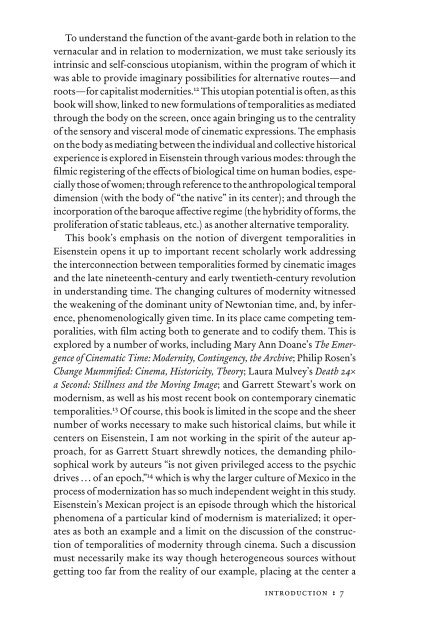In Excess: Sergei Eisentein's Mexico - Cineclub
In Excess: Sergei Eisentein's Mexico - Cineclub
In Excess: Sergei Eisentein's Mexico - Cineclub
You also want an ePaper? Increase the reach of your titles
YUMPU automatically turns print PDFs into web optimized ePapers that Google loves.
To understand the function of the avant-garde both in relation to the<br />
vernacular and in relation to modernization, we must take seriously its<br />
intrinsic and self-conscious utopianism, within the program of which it<br />
was able to provide imaginary possibilities for alternative routes—and<br />
roots—for capitalist modernities. 12 This utopian potential is often, as this<br />
book will show, linked to new formulations of temporalities as mediated<br />
through the body on the screen, once again bringing us to the centrality<br />
of the sensory and visceral mode of cinematic expressions. The emphasis<br />
on the body as mediating between the individual and collective historical<br />
experience is explored in Eisenstein through various modes: through the<br />
fi lmic registering of the effects of biological time on human bodies, especially<br />
those of women; through reference to the anthropological temporal<br />
dimension (with the body of “the native” in its center); and through the<br />
incorporation of the baroque affective regime (the hybridity of forms, the<br />
proliferation of static tableaus, etc.) as another alternative temporality.<br />
This book’s emphasis on the notion of divergent temporalities in<br />
Eisenstein opens it up to important recent scholarly work addressing<br />
the interconnection between temporalities formed by cinematic images<br />
and the late nineteenth-century and early twentieth-century revolution<br />
in understanding time. The changing cultures of modernity witnessed<br />
the weakening of the dominant unity of Newtonian time, and, by inference,<br />
phenomenologically given time. <strong>In</strong> its place came competing temporalities,<br />
with fi lm acting both to generate and to codify them. This is<br />
explored by a number of works, including Mary Ann Doane’s The Emergence<br />
of Cinematic Time: Modernity, Contingency, the Archive; Philip Rosen’s<br />
Change Mummifi ed: Cinema, Historicity, Theory; Laura Mulvey’s Death 24×<br />
a Second: Stillness and the Moving Image; and Garrett Stewart’s work on<br />
modernism, as well as his most recent book on contemporary cinematic<br />
temporalities. 13 Of course, this book is limited in the scope and the sheer<br />
number of works necessary to make such historical claims, but while it<br />
centers on Eisenstein, I am not working in the spirit of the auteur approach,<br />
for as Garrett Stuart shrewdly notices, the demanding philosophical<br />
work by auteurs “is not given privileged access to the psychic<br />
drives . . . of an epoch,” 14 which is why the larger culture of <strong>Mexico</strong> in the<br />
process of modernization has so much independent weight in this study.<br />
Eisenstein’s Mexican project is an episode through which the historical<br />
phenomena of a particular kind of modernism is materialized; it operates<br />
as both an example and a limit on the discussion of the construction<br />
of temporalities of modernity through cinema. Such a discussion<br />
must necessarily make its way though heterogeneous sources without<br />
getting too far from the reality of our example, placing at the center a<br />
introduction : 7


